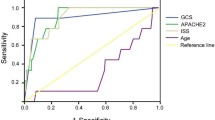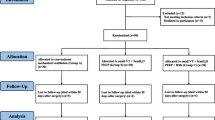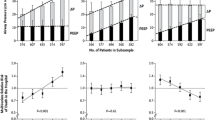Abstract
The objective of this study is to observe the effects of high dose of anisodamine in the respiratory function of patients with acute lung injury (ALI) induced by trauma. Fifty cases of patients with complicated ALI after trauma were randomly divided into the anisodamine treatment group (n = 26) and the conventional treatment group (n = 24). Intravenous injection of high dose of anisodamine was administrated in the anisodamine treatment group on the basis of conventional treatment. Acute lung injury scores, oxygenation index, PaO2, respiratory mechanic index, mechanical ventilation time, and the occurrence of adverse reactions in the two groups were observed. Acute lung injury scores and respiratory parameters were all significantly improved in the two groups of patients after the treatment (P < 0.05); compared with the conventional treatment group, the improvements of respiratory function in the anisodamine treatment group were more obvious (P < 0.05), the mechanical ventilation time was shorter (P < 0.05), and there was no significant adverse reaction. In conclusion, high dose of anisodamine contributed to improve the respiratory function of the patients with traumatic ALI.
Similar content being viewed by others
References
Rubenfeld, G. D. (2005). Incidence and outcomes of acute lung injury. The New England Journal of Medicine, 353(11), 1685–1693.
Yang, G., & Yao, X. (2004). Exploration of treatment with hembane drugs for acute lung injury and its pharmacological basis. Chinese Journal of Critical Care Medicine, 24(4), 281–283. In Chinese.
Society of Critical Care Medicine of Chinese Medical Association. (2006). Guideline of the diagnosis and treatment of ALI/ARDS. Chinese Journal of Critical Care Medicine, 18(12), 706–710. In Chinese.
Ren, H., Ren, Y., Chen, W., et al. (2003). Clinical observation of the treatment with high dose of anisodamine for acute lung injury after thoracotomy. Journal of Xian Jiaotong University (Medical Sciences), 24(1), 90–91. In Chinese.
Cheng, S., & Luo, J. (2010). Analysis of the curative effect of the treatment with high dose of anisodamine for septic shock. Chinese Journal of Modern Drug Application, 4(14), 161–162. In Chinese.
Lv, W., Tang, X., Zhong, G., et al. (2006). Anisodamine hyoscyaminization treating arthritis deformans and its effects on the changes of the endocrine hormones of hypothalamic-pituitary-adrenal axis. Journal of Gannan Medical University, 18(4), 504–506. In Chinese.
Qiu, H., & Zhou, S. (2001). Modern Treatment of Multiple Organ Dysfunction Syndrome (pp. 90–91). Beijing: People’s Military Medical Press. In Chinese.
Qian, G., & Chen, X. (2010). Research progress in the pathogenesis of ALI/ARDS. Journal of Internal Medicine Concepts & Practice, 5(6), 460–463. In Chinese.
Cao, H., Lv, S., Jiang, Y., et al. (2006). Changes in oxygen free radicals and comparisons of therapeutic effects of different traditional Chinese medicinal herbs in rats with acute lung injury. Chinese Journal of Integrated Traditional and Western Medicine in Intensive and Critical Care, 13(13), 146–149. In Chinese.
Middlebrook, A. J., Martina, C., Chang, Y., et al. (2002). Effects of nicotine exposure on T cell development in fetal thymus organ culture: arrest of T cell maturation. Journal of Immunology, 169(10), 2915–2924.
Yu, C., & Sun, H. (2006). Hot topics of non-ventilation treatment of acute lung injury. Chinese Journal of Critical Care Medicine, 26(7), 534–536. In Chinese.
Yang, K., & Yang, L. (2010). Progress in the pharmacology and clinical study of anisodamine. World Clinical Drugs, 31(3), 182–186. In Chinese.
Razavi, H. M., Wang, L. F., Weicker, S., et al. (2004). Pulmonary neutrophil infiltration in murine sepsis: role of inducible nitric oxide synthase. American Journal of Respiratory and Critical Care Medicine, 170(3), 227–230.
Author information
Authors and Affiliations
Corresponding author
Rights and permissions
About this article
Cite this article
Guoshou, Z., Chengye, Z., Zhihui, L. et al. Effects of High Dose of Anisodamine on the Respiratory Function of Patients with Traumatic Acute Lung Injury. Cell Biochem Biophys 66, 365–369 (2013). https://doi.org/10.1007/s12013-012-9475-6
Published:
Issue Date:
DOI: https://doi.org/10.1007/s12013-012-9475-6




